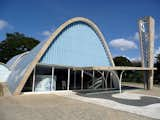10 Inspiring Modern Churches
From the scale and ambition of Europe’s grand cathedrals to humble roadside buildings turned into places of spiritual retreat, church architecture has always been a fertile field for artistic expression and technological innovation. While the form is literally thousands of years old, it doesn’t mean that new spins on established forms can’t continue to amaze. We rounded up some of the most impressive examples of modern church construction from the mid-20th century to date.
Oscar Niemeyer, Church of St. Francis of Assisi
The Brazilian master of curved concrete made his mark with the Pampulha Architectural Ensemble, a 1940s garden city project in Belo Horizonte, the capital of the state of Minas Gerais. The complex, which was one of Niemeyer’s first, included the radical Church of St. Francis of Assisi. This modernist touchstone with a parabolic roof and polychromatic tiles was such a departure from existing forms that one politician suggested demolishing it. In 2016, the cathedral was added to UNESCO’s World Heritage List.
Marcel Breuer, St. John’s Abbey
Le Corbusier, Notre-Dame du Haut
What looks like an abstracted cottage from a distance, with whitewashed walls and a strangely curved roof, is actually a magnificent 1950s chapel on the Bourlémont hilltop in Ronchamp, France, designed by the modernist architect. The bent roof that creates a natural fountain when it rains, as well as the overall sculptural form, make it a celebrated outlier in Corbu’s career. A wall with small slits and squares cut for light produces a glittering, spiritual calm from inside.
Richard Meier, Jubilee Church
Walter A. Netsch, Cadet Chapel
Looking more like a space-age battleship than a house of worship from certain angles, this futuristic 1959 chapel is an angular assemblage of five-ton metal tetrahedrons, built out of the same aluminum panels as jet fighter wings. The ecclesiastical building, located at the U.S. Air Force Academy near Colorado Springs, Colorado, won the American Institute of Architects’ 25 Year Award and is now a U.S. National Historic Landmark. Its set of 17 spires might as well be a squadron screaming toward the heavens.
Fay Jones, Thorncrown Chapel
Arkansas native Jim Reed hired Frank Lloyd Wright protégé Fay Jones to build this 1980 Eureka Springs chapel as a waystation of sorts for visitors on his land, who passed through seeking the magnificent views of the Ozarks. The 48-foot-tall wood-and-glass chapel won Jones the American Institute of Architects’ Design of the Year Award for 1981.
Philip Johnson, Crystal Cathedral
Home to the massive congregation of preacher Robert Schuller, famous for the Hour of Power television show, this 1981 cathedral certainly puts the mega in megachurch. Technically a tower of glass, the $18 million structure designed by Philip Johnson utilizes silicon-based glue to hold the 10,000 glass panes in place. In 2019, the postmodern ecclesiastical structure reopened after a renovation by the Catholic church, which purchased the space after Schuller went bankrupt.
I.M. Pei, Luce Memorial Chapel
When I.M. Pei designed this 1963 chapel for Tunghai University in Taiwan, the renowned architect had to take local conditions, like typhoons and earthquakes, into account. His plan—which included a curved roof of glazed, diamond-shaped tiles and interior ribs of reinforced concrete that run like ribbons toward the rooftop cross—was an elegant solution to the challenges of the local environment.
Shigeru Ban, Cardboard Cathedral
A testament to the strength, skill, and poignancy of the Japanese Pritzker Prize winner’s "emergency architecture," this A-frame marvel of cardboard tubing and shipping containers served as a potent symbol for the recovery of Christchurch, New Zealand, two years after a disastrous 2011 earthquake. A stained glass triangle at the front of the church incorporates imagery from the famous facade of the site’s original cathedral.
Divece Arquitectos, Capilla del Lago
Published
Last Updated
Get the Dwell Newsletter
Be the first to see our latest home tours, design news, and more.









